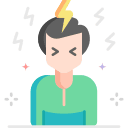CYAMEMAZINE
THERAPEUTICS
Class
- Conventional antipsychotic (neuroleptic, phenothiazine, dopamine 2 antagonist, serotonin–dopamine antagonist)
CYAMEMAZINE commonly prescribed for
(Bold for FDA approved)
 How CYAMEMAZINE works
How CYAMEMAZINE works
• Blocks dopamine 2 receptors, reducing positive symptoms of psychosis
• Although classified as a conventional antipsychotic, cyamemazine is a potent serotonin 2A antagonist
• Affinity at a myriad of other neurotransmitter receptors may contribute to cyamemazine’s efficacy
• Specifically, antagonist actions at serotonin 2C receptors may contribute to notable anxiolytic effects in many patients
• Serotonin 2C antagonist actions may also contribute to antidepressant actions in severe depression and to improvement of cognitive and negative symptoms of schizophrenia in some patients
How long until CYAMEMAZINE works
• Psychotic symptoms can improve with high doses within 1 week, but it may take several weeks for full effect on behavior
• Anxiolytic actions can improve with low doses within 1 week, but it may take several days to weeks for full effect on behavior
SIDE EFFECTS
 Notable Side Effects
Notable Side Effects
Neuroleptic-induced deficit syndrome (unusual at low doses)
• Akathisia
• Drug-induced parkinsonism, tardive dyskinesia (unusual at low doses)
• Galactorrhea, amenorrhea (unusual at low doses)
• Hypotension, tachycardia (unusual at low doses)
• Dry mouth, constipation, vision disturbance, urinary retention
• Sedation
• Decreased sweating
• Weight gain (may be unusual at low doses)
• Sexual dysfunction
• Metabolic effects, glucose tolerance
 Life Threatening Side Effects
Life Threatening Side Effects
• Rare neuroleptic malignant syndrome
• Rare seizures
• Rare jaundice, agranulocytosis
• Increased risk of death and cerebrovascular events in elderly patients with dementiarelated psychosis
weight gain

unusual
sedation

common
What to do about CYAMEMAZINE side effects
• Wait
• Wait
• Wait
• For motor symptoms, add an anticholinergic agent
• Reduce the dose
• For sedation, give at night
• Switch to an atypical antipsychotic
• Weight loss, exercise programs, and medical management for high BMIs, diabetes, dyslipidemia
DOSING AND USE
usual dosage range
• 50–300 mg at bedtime for treatment of psychosis
• 25–100 mg for anxiety; duration of treatment 4 weeks
• Children (ages 6 and older): 1–4 mg/kg per day
• Injection: 25–100 mg/day
 Dosage Forms
Dosage Forms
• Tablet 25 mg, 100 mg
• Oral solution 40 mg/mL
• Injection 50 mg/5 mL
long term use
• Some side effects may be irreversible (e.g., tardive dyskinesia)
habit forming
• No
SPECIAL POPULATIONS
 Renal Impairment
Renal Impairment
• Use with caution
 Hepatic Impairment
Hepatic Impairment
• Use with caution
 Cardiac Impairment
Cardiac Impairment
• Cardiovacular toxicity can occur, especially orthostatic hypotension
 Elderly
Elderly
• Elderly patients may be more susceptible to adverse effects
• Lower doses should be used and patient should be monitored closely
• Generally, doses above 100 mg/day are not recommended
• Elderly patients with dementia-related psychosis treated with antipsychotics are at an increased risk of death compared to placebo, and also have an increased risk of cerebrovascular events
 Children and Adolescents
Children and Adolescents
• Sometimes used for severe behavioral disturbances in children ages 6 and older
• Oral solution is preferable to the other formulations
 Pregnancy
Pregnancy
• There is a risk of abnormal muscle movements and withdrawal symptoms in newborns whose mothers took an antipsychotic during the third trimester; symptoms may include agitation, abnormally increased or decreased muscle tone, tremor, sleepiness, severe difficulty breathing, and difficulty feeding
• Reports of drug-induced parkinsonism, jaundice, hyperreflexia, hyporeflexia in infants whose mothers took a phenothiazine during pregnancy
• Phenothiazines should only be used during pregnancy if clearly needed
• Psychotic symptoms may worsen during pregnancy and some form of treatment may be necessary
• Atypical antipsychotics may be preferable to phenothiazines or anticonvulsant mood stabilizers if treatment is required during pregnancy
 Breast Feeding
Breast Feeding
• Unknown if cyamemazine is secreted in human breast milk, but all psychotropics are assumed to be secreted in breast milk
• Recommended either to discontinue drug or bottle feed
Based on data Published online by Cambridge University Press
Compiled by Dr. Jash Ajmera